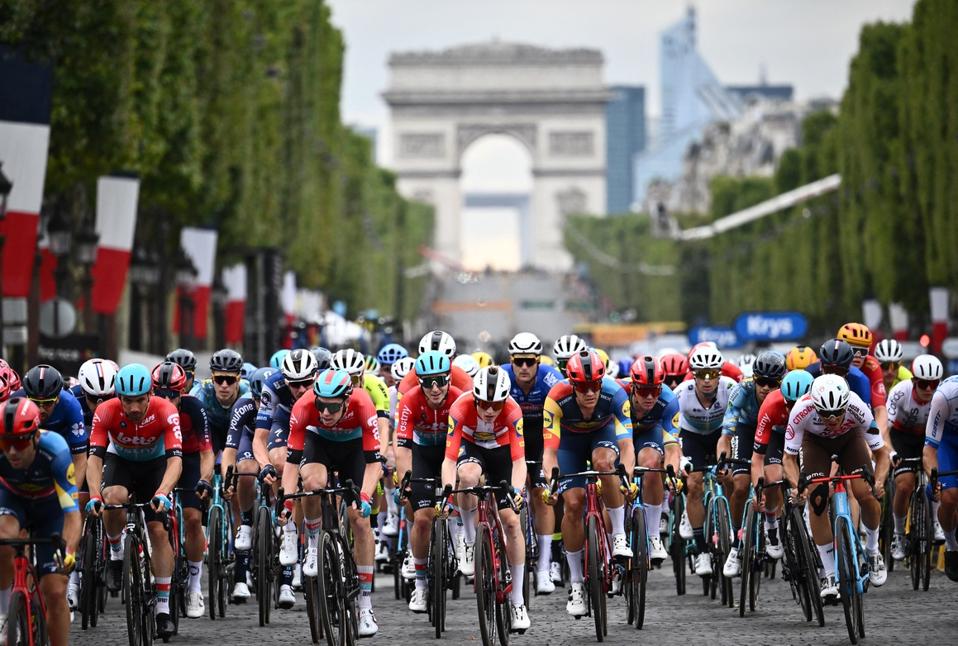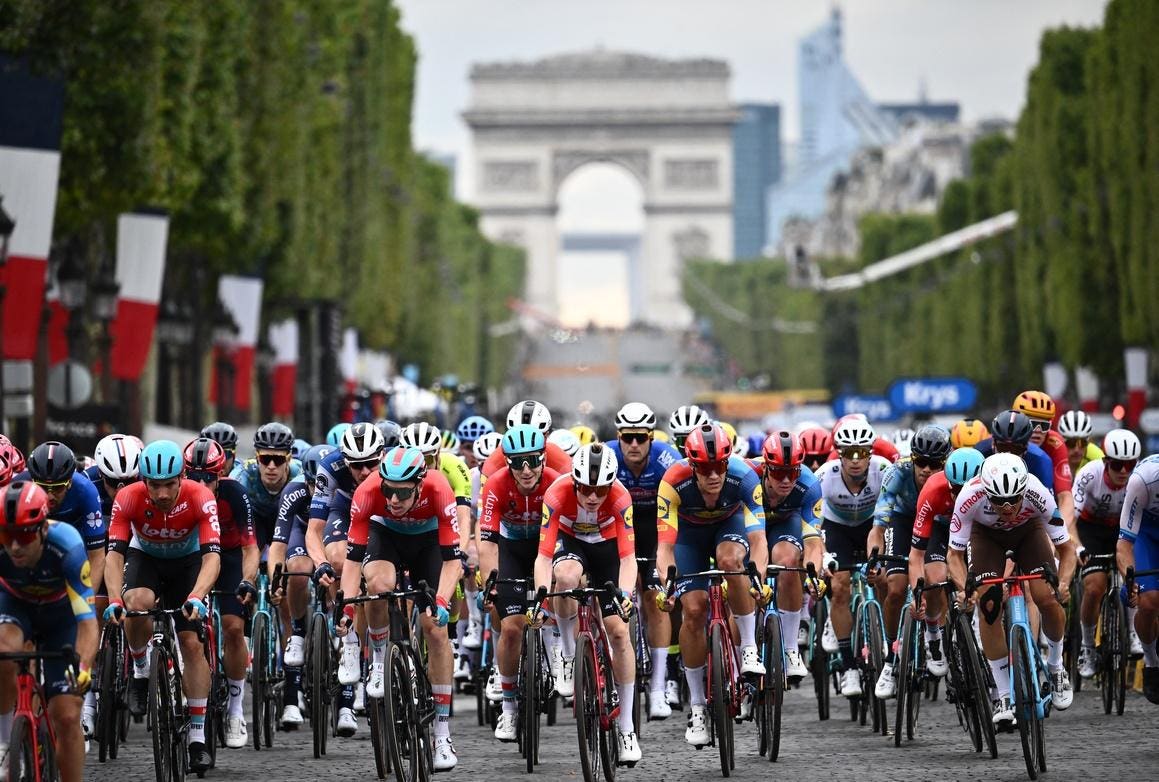
The pack cycles on the Champs Elysee avenue with the Arc de Triomphe in the background during the … More 21st and final stage of the 110th edition of the Tour de France cycling race, 115 km between Saint-Quentin-en-Yvelines and the Champs-Elysees in Paris, on July 23, 2023. (Photo by Marco BERTORELLO / AFP) (Photo by MARCO BERTORELLO/AFP via Getty Images)
AFP via Getty Images
Live streaming and broadcasting technology have revolutionized how fans can follow professional cycling events, such as the Tour de France. Where once getting live coverage of this multi-stage race was challenging, today’s technology enables viewers to watch every moment, no matter where they are in the world.
Beginnings: 1948-1967
General view of cyclists on Rue de Rivoli during Stage 1 of the Tour De France, after departing from … More near the Louvre Museum, France, 30th June 1948. (Photo by FPG/Archive Photos/Getty Images)
Getty Images
The first live television broadcast from the Tour de France was in 1948, when the arrival at the velodrome of Parc des Princes was broadcast live. Previously, images of
the Tour de France had only been shown on cinema newsreels, usually up to a week after the action took place. This cycling premiere was largely symbolic, though: only a few thousand Parisians were able to see the broadcast, and the images were so fuzzy that it was hard to distinguish any riders.
The positive reactions to the 1948 live transmission of the Tour de France prompted French television to introduce a news program in 1949. The first-ever French television news program was broadcast on June 29, 1949, a day before the start of that year’s Tour de France. News programs aired three times weekly just for the duration of the Tour de France and consisted primarily of roughly fifteen minutes of footage from the previous day’s stage. Tour de France news programs grew in popularity in the 1950s, but live coverage remained rare. Since images still had to be shot with a fixed camera, the length of the TV cables used at the time limited the opportunities for such live broadcasts.
(Original Caption) Editor’s notes: Paris, July 19, 1958. 45th “Tour de France” (Brussels-Paris). … More Dramatic fall of the French rider Andre Darrigade (who’d already won 5 laps) on the Parc des Princes track, at the arrival of the 24th and last lap disputed between Dijon and Paris. He slams into a track official who was too close to the track.
Bettmann Archive
In 1958, broadcasters began filming the Tour from cars for the first time, followed by cameramen on motorcycles for the first time in 1962. Finally in 1963 daily live filming of every stage began.
Front runners of the 1963 Tour de France cycling through the mountains. The group includes Jacques … More Anquetil, Federico Bahamontes and Raymond Poulidor.(Photo by Roger Viollet via Getty Images)
Roger Viollet via Getty Images
Phase II: 1968-1991 The Product Gets Better
In 1968 live television broadcasts extended beyond France to the rest of Europe via the Eurovision network. Then in 1971 broadcasters began experimenting with color TV. By 1974 the entire Tour would be broadcast in color.
VINCENNES, FRANCE – JULY 21: Belgian champion Eddy Merckx (yellow jersey) races his last meters, 21 … More July 1974 at the velodrome municipal in Vincennes, before winning the Tour de France for the fifth time. During his career Merckx won 524 races, captured 3 World Road champion titles (1967, 71, 74), won five times the Tour de France (1969, 70, 71, 72, 74) and the Tour d’Italie (1968, 70, 72, 73, 74). (Photo credit should read STAFF/AFP via Getty Images)
AFP via Getty Images
As the Tour continued into the 1980’s the broadcast expanded to more countries outside Europe including the United States and Japan. And in 1990 the Tour witnessed the first broadcast of a stage live from start to finish.
FILES, FRANCE: Greg LeMond of the US rides on the Champs Elysees in a 23 July 1989 during the last … More stage of the Tour de France which he won three times. LeMond is expected to officially announce his retirement late 03 December 1994 in California. LeMond said wounds from an accidental shooting in 1987 are forcing him to retire. (Photo credit should read FILES/AFP via Getty Images)
AFP via Getty Images
Phase III: 1992-2025 Globalization Of An Upscale Product
In 1992 for the first time aerial coverage shot from an airplane was used. Then in 2007 video images shot with high definition cameras really enhanced the viewer experience. In 2013 drones would be used to film landmarks and landscapes along the Tour de France route. And in 2014 for the first time race organizers would allow competitors to ride with small, bike-mounted video cameras to give viewers a birds-eye view of the race. Finally In 2017 all Tour de France stages would be broadcast live from start to finish.
An aerial view shows the Mont-Saint-Michel during the 11th stage, a time trial over 33km, of the … More 100th edition of theTour de France 2013 cycling race between Avranches and Mont-Saint-Michel on July 10, 2013. AFP PHOTO / POOL / YOAN VALAT (Photo credit should read YOAN VALAT/AFP via Getty Images)
AFP via Getty Images
Today: Every Moment Of Every Stage
So where once getting live coverage of this multi-day/ multi-stage event was very difficult, today technology allows viewers to watch every moment of every stage–no matter where they are in the world.
And it’s not just the multitude of cameras covering the Tour on the ground and in the air–it’s data.
On-Bike Sensors
LEEDS, ENGLAND – JULY 05: A small video camera is mounted under the handle bars of one of the … More riders to provide in race video during stage one of the 2014 Tour de France from Leeds to Harrogate on July 5, 2014 in Leeds, United Kingdom. (Photo by Doug Pensinger/Getty Images)
Getty Images
In addition to cameras mounted on riders’ bikes, there are also onboard sensors. These sensors produce real-time data on things like: speed, heart rate and power output. This opens up new perspectives for viewers further inviting them into the race experience. The live data also helps the race commentators better analyze rider tactics and performance.
Helicopter and Motorcycle Cameras
Briancon, FRANCE: A France Television helicopter equipped with a camera follows the race for the … More live broadcast during the ninth stage of the 94th Tour de France cycling race between Val d’Isere and Briancon, 17 July 2007. AFP PHOTO / JOEL SAGET (Photo credit should read JOEL SAGET/AFP via Getty Images)
AFP via Getty Images
Aerial camera coverage of the Tour has long been an important part of the viewer experience. Live helicopter shots using gyro-stabilized cameras accomplish this well. In addition though, the use of cameras on stealthy motorbikes weaving in amongst the peloton have become a key source of live footage and provide exciting new images and perspectives.
Le Tour de France 2016. Sallanches – Megeve in the french Alps. Chris Froome of Great Britain and … More Team Sky. France. (Photo by: Godong/Universal Images Group via Getty Images)
Universal Images Group via Getty Images
Broadcasting From Team Cars
Outfitting team cars and buses with cameras has also become standard practice at every Tour. This allows for live interviews with team directors and inside perspectives on how teams are responding in real time to events on the road. This access to team communications further enhances storytelling opportunities for broadcasters.
PARIS, FRANCE – JULY 29: Geraint Thomas of Great Britain and Team Sky Yellow Leader Jersey / Dave … More Brailsford of Great Britain Team Manager of Team Sky / Celebration / Champagne / Car / during the 105th Tour de France 2018, Stage 21 a 116km stage from Houilles to Paris Champs-Elysees / TDF / on July 29, 2018 in Paris, France. (Photo by Pool – Tim de Waele/Getty Images)
Getty Images
A Complex Network Of Transmitters
Today, the Tour de France offers uninterrupted live video coverage of stage races often covering over 100 miles. This can only be accomplished with a network of wireless video transmitters along each racecourse, relaying live footage back to a production hub. On-bike cameras have transmitters that send signals to nearby motorbikes. In turn, relay helicopters transmit video back to fixed receivers stationed along a given route. And it all collectively enables wider broadcasting of the event.
Mission Control Creates The Finished Product
PARIS, FRANCE – JULY 24: Sanne Cant of Belgium and Team Plantur-Pura, Christina Schweinberger of … More Austria and Team Plantur-Pura, Elisa Balsamo of Italy and Team Trek- Segafredo, Eugenia Bujak of Slovenia and UAE Team ADQ, Audrey Cordon-Ragot of France and Team Trek- Segafredo, Margarita Victoria Garcia Cañellas of Spain and UAE Team ADQ, Nicole Frain of Australia and Team Parkhotel Valkenburg, Frances Janse Van Rensburg of South Africa and Team Stade Rochelais Charente Maritime, Petra Stiasny of Switzerland and Team Roland Cogeas Edelweiss/Israel-Premier Tech and Cecilie Uttrup Ludwig of Denmark, Team Fdj Nouvelle – Aquitaine Futuroscope and The Peloton prior to the 1st Tour de France Femmes 2022, Stage 1 a 81,7km stage from Paris – Tour Eiffel to Paris – Champs-Élysées / #TDFF / #UCIWWT / on July 24, 2022 in Paris, France. (Photo by Dario Belingheri/Getty Images)
Getty Images
Once the live video, data, and audio have been transmitted back to the host broadcaster’s studio production truck, dozens of video and audio technicians piece together the live broadcast by quickly switching between different video feeds and graphics. This mobile studio has all the capabilities of a full TV production control room to create packaged highlight segments and live interviews!
The Tour de France logo adorns the podium at the finish line of the 12th stage of the 111th edition … More of the Tour de France cycling race, 203,6 km between Aurillac and Villeneuve-sur-Lot, southwestern France, on July 11, 2024. (Photo by Marco BERTORELLO / AFP) (Photo by MARCO BERTORELLO/AFP via Getty Images)
AFP via Getty Images
From the mobile studio, the live broadcast is distributed simultaneously via satellite links and online streams to TV networks all over the globe. Online live streaming allows any viewer with an internet connection anywhere in the world to tune in via their device. Platforms like YouTube, Facebook, and cycling websites carry the stream live for their digital audiences.
Even TikTok has emerged as an important digital channel for events like the Tour. Julien Groupi, Media and Partnerships Director at the Amateur Sports Organization, recently stated: “The uniqueness of the content offered by TikTok is a perfect match for the Tour de France’s ambition: to make the event known everywhere, to everyone, and with the spontaneous and creative eye of fans. The content created at the roadside will enhance existing coverage and bring the public together around the event even more widely.”
A Media Phenomenon
LE MONT-DORE PUY DE SANCY, FRANCE – JULY 14: (EDITOR’S NOTE: Alternate crop) (L-R) Tadej Pogacar of … More Slovenia and UAE Team Emirates – XRG – Yellow leader jersey and Jonas Vingegaard of Denmark and Team Visma | Lease a Bike cross the finish line during the 112th Tour de France 2025, Stage 10 a 165.3km stage from Ennezat to Le Mont-Dore Puy de Sancy (Super Sancy) 1318m / #UCIWT / on July 14, 2025 in Le Mont-Dore Puy de Sancy, France. (Photo by Dario Belingheri/Getty Images)
Getty Images
Innovations in video technology, wireless transmission, and broadcasting over the past seventy years have changed the Tour into an event followed by primarily french cycling enthusiasts and purists to a global media event. The 2024 Tour de France reached over 150 million viewers in Europe alone, with a total of 700 million hours of live television watched across the continent. Globally, the race was broadcast in 190 countries on 100 channels, and total viewing hours exceeded one billion, according to Cyclingnews.com.
